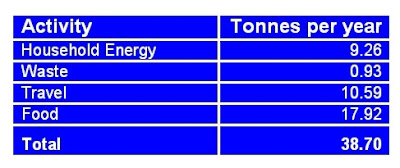
Everything has a carbon footprint. But when most of us think of our carbon footprint we think in terms of the carbon emissions from energy, such as electricity or transport. Few people would consider the large contribution to the household carbon footprint of food. However, a recent study by Taverner Research (commissioned by Willoughby Council on Willoughby residents), looked at the holistic carbon footprint per household and found that almost half the emissions, 47% on average, are a result of the food we buy.
The study shows that a household of three people is responsible for 38.7 tonnes of carbon emissions per annum on average, with food being the largest contributor (47%), then travel (27%), Household Energy - including electricity, gas, heating and cooling (24%) and Waste (2%). Table 1 shows the household carbon emissions per activity in tonnes of CO2e.
Table 1: Carbon Emissions per household activity

Interestingly, but not unexpected, the research showed that carbon emissions per occupant decreases as the number of people living in the household increases. Because occupants share some energy consumption and therefore each occupant is responsible for fewer carbon emissions. The study found that an individual on their own is responsible for 14.9 tonnes of carbon emissions on average, which is much higher than the average carbon emissions per individual across all research participants of 11.97 tonnes.
Carbon emissions are almost one-third lower per occupant in a household of five people compared to a household with a sole occupant.

This research clearly shows we need to consider more than just the energy we use when considering our impact on the environment. While there is merit in cohabitation in order to reduce the carbon emissions per occupant, the real opportunities to reduce our carbon footprint appear to be found in what we eat. A big part of an individual’s carbon footprint comes from food. Our next article looks at ways to reduce your carbon footprint from food.

I agree that most people do not think of their food choices when they think of carbon footprint but this awareness is not "new" to other countries. Europe has been ahead of the US in awareness for some time. They have been labeling food with chemical content, foods that are genetically modified and are starting to label foods with carbon content. This labeling gives consumers valuable information so they can make wise choices. Here is an article, http://www.foodnutritionscience.com/index.cfm/do/monsanto.article/articleId/91.cfm, dating back to 2007 that talks about the green movement and including carbon reduction labels on foods to help educate consumers. They even mention US companies wanting to get involved. This tells me that we need to step up our education in this country, so people will start speaking up. Companies need to know that we are also interested in getting more information about our food so we can make wiser choices. Reading articles like this one helps get us on the right track. Thank you!
ReplyDeleteJennipher
www.offsetproject.org
Our mission is to inspire the community toward green action, one sustainable project at a time
Thanks Jennipher. We liked your food labelling information so much that it was referenced in the Climakind August Progress Report
ReplyDeleteCheers!
Including carbon reduction labels on foods to help educate consumers is becoming important given the chemical intensity and resource concentration of agriculture in general.Green revolution has meant more widespread and intense use of agrichemicals to promote plant growth and improve crop yields and productivity of agri farming in general.. Greater awareness may even icentivise companies wanting to get involved provided there is a practice of green labelling and carbon labelling for food products which can attract consumers and customers-that means greater awareness creation particularly in a developing country context like that of India,China,Brazil etc.Less chemical,energy and hence carbon intense agrifarming practices have to be promoted and biochar options need to be investigated in greater earnest.In developing countries integrated farming practices that still exist in some villages can be intensified and expanded where animal husbandry and biomass cultivation can provide inputs of a carbon neutral nature for agriculture and farms.
ReplyDeleteThe climate change impacts have started affecting crop yields in areas where there are higher temperatures and less rainfall. The anomalous precipitation patterns and extreme weather events are also telling on agriculture and farms are being increasingly prone to insect attacks as a consequence to increased temperature and humidity conditions in many parts of the world.The climate change impacts are more in vulnerable areas of the world which are mostly in the less developed regions.Hence carbon neutral cultivation has greater meaning there-policies should help in introducing carbon labelling of foods so as to promote income flows to farming community in developing and less developed areas through financial technologies analogous to REDD initiatives,but involving the local communities in a more meaningful and sustainable manner.
Organic farming needs to be promoted though it has its own negatives. SURESHKUMAR.S,SCIENTIST AND ADVISER,NIIST[CSIR],TRIVANDRUM,INDIA
This is a good post. This post gives truly quality information. I’m definitely going to look into it. Really very useful tips are provided here. Thank you so much. Keep up the good works Electrode Carbon Paste
ReplyDelete